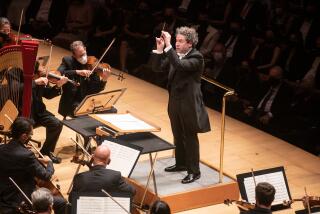Music review: A brilliant Brahms duo of Yo-Yo Ma and Emmanuel Ax
Brahms and Tchaikovsky made an effort to be civil to each other when the German and Russian composers met, and that was impressive.
In an infamous review, Edward Hanslick, the most powerful critic in 19th century Vienna and Brahms’ mouthpiece, credited Tchaikovsky as the first composer to write music “that stinks in the ear.” Tchaikovsky called Brahms a “self-inflated mediocrity.”
This week there is a Tchaikovsky lockdown in Walt Disney Concert Hall, thanks to daily programs in the Los Angeles Philharmonic’s magnificent TchaikovskyFest. But Tuesday night, when Tchaikovsky wasn’t looking, that self-inflated mediocrity held his nose and slipped into the building.
PHOTOS: Best classical concerts of 2013 | Mark Swed
With the L.A. Phil also hosting pianist Emanuel Ax’s Brahms Project this season, Tuesday was the occasion for a recital program of three Brahms cello sonatas with Yo-Yo Ma. A breath of fresh Brahms air proved magnificent too. It helped, however, that a whiff of Tchaikovsky could still be discerned.
An hour before the recital, members of the Simón Bolívar Symphony Orchestra of Venezuela had joined students in YOLA (Youth Orchestra of Los Angeles) for an inspiring performance of Tchaikovsky’s Second Symphony at the Cathedral of Our Lady of the Angels.
Afterward, seats were added to the Disney stage so that several Bolívars might rush over to hear Ma and Ax. The Venezuelans’ intense listening inserted energy into the atmosphere, and Ma delightedly gave them thumbs-up gestures at curtain calls.
PHOTOS: Faces to watch 2014 | Classical music
When it comes to Ax and Ma, who have long been friends, the passionate cellist is more the Tchaikovskian than the subdued if equally warm pianist. Ma, for instance, has played Tchaikovsky’s “Rococo” Variations countless times (including at the L.A. Phil’s opening night gala this season), whereas Ax is not known for playing the Russian composer, at least in public.
That’s the dynamic, as well, of the players’ musical partnership. Ever the rhapsodic cellist, Ma makes an expressive meal of Brahms’ melodies, while Ax remains in the background, seemingly backing him up.
But a more complex and interesting dynamic occurs with these partners, and that is what made for greatness on Tuesday.
PHOTOS: LA Opera through the years
Twenty-two years ago, Ma and Ax recorded two Brahms cello sonatas. The performances are wonderfully eloquent and sophisticated, sounding as fine today as they did then. Ax commands clear lines and exquisitely weighted harmonies. The cello slides alongside the piano.
The two sonatas are as appealing as anything Brahms wrote. The first, in E minor, is relatively early. Its melodies are, in their own way, as powerfully olfactory as Tchaikovsky’s; they suffuse your senses. The self-inflation is there in a last movement that showily channels Bach — and quite effectively.
The second sonata, in F major, is one of Brahms’ towering chamber pieces. Here, the melodies are downright overpowering. Tchaikovsky could never come up with the structures Brahms constructs or the harmonic ambiguities, but the Russian would have been slicker with rhythmic irregularity.
PHOTOS: Operas by Philip Glass
The composers’ competition is, of course, long over, except that it really wasn’t in this performance. Ma has become freer and more overly dramatic over the years. Sometimes that can seem showy. In the F major sonata, though, Ma brought depth, digging into notes to bring out their essence.
But he couldn’t have done that nearly as extravagantly or brilliantly without Ax. It was the pianist who knew exactly where the emphasis of a phrase should be, where to give Ma room and where to rope him in. Ax, a consummate Brahmsian on every level, was the one in real control.
Ax had intended to pair these sonatas with two new works. Australian composer Brett Dean’s “Hommage à Brahms” for solo piano was finished in time. But a duo for Ax and Ma by Swedish composer Anders Hillborg was not and had to be replaced by Brahms’ First Violin Sonata in a cello transcription.
Dean’s score, an L.A. Phil co-commission, is in three short parts, intended as interludes to Brahms’ four final piano pieces, Opus 119. Ax, instead, played them on their own. They slip back and forth between Brahms’ time and our own, evoking a kind of nostalgia for the past without wallowing. Ax played them with fluid grace.
Fluid grace was what Brahms’ violin sonata has going for it. In its cello guise it takes on heft. Ma and Ax added radiance.
More to Read
The biggest entertainment stories
Get our big stories about Hollywood, film, television, music, arts, culture and more right in your inbox as soon as they publish.
You may occasionally receive promotional content from the Los Angeles Times.







